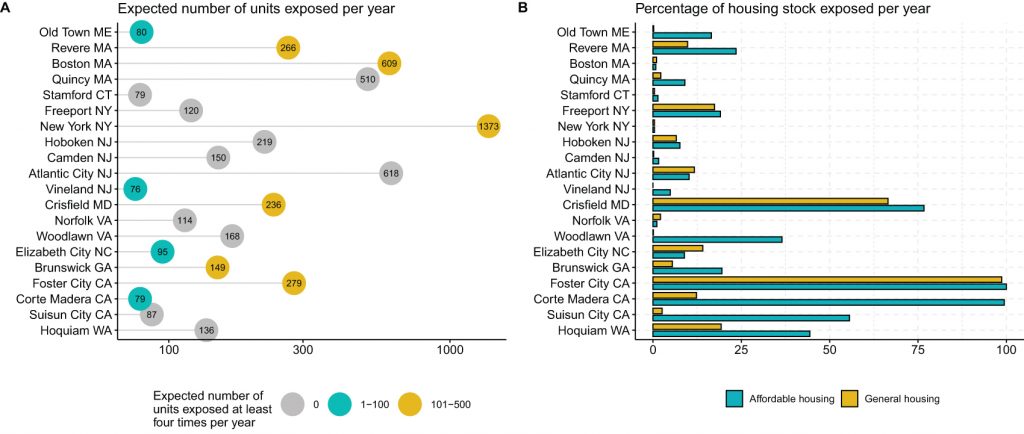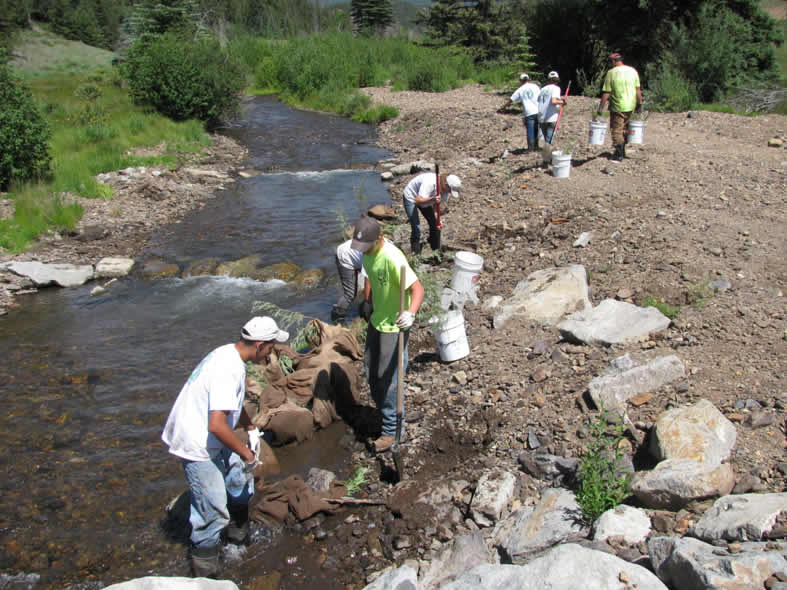A study published in the journal Environmental Research Letters finds that affordable housing in the U.S. is far more likely to experience coastal flooding from sea-level rise relative to other types of housing. The study, published December 2020, proposes a new metric to assess a building’s vulnerability to coastal flooding.
The researchers estimate that the number of U.S. housing units at risk has tripled over the past 20 years. They project that more than 24,000 affordable housing buildings in the U.S. could be exposed by 2050, at which point more than 10,000 affordable units are likely to face chronic flooding four times per year or more – often making them unlivable.
“Many cities are already struggling with an affordable housing crisis,” said study co-author Lara Cushing, assistant professor of environmental health sciences at the University of California, Los Angeles (UCLA), in a release. “Our study highlights that climate change will only make this worse unless significant investments are made.”
Assessing Vulnerability
Study authors assessed flooding risks for different types of housing by interpreting data from 71 tide gauge stations across the U.S. to determine the annual probability that the crests of a coastal flooding event would rise high enough to cause damages to local buildings. Notably, the study proposes a new metric called expected annual flood-risk events, which measures the total expected number of flood-risk events a building could experience based on tide-gauge data considered alongside local topographical information gathered from a digital elevation model.
After incorporating various standardized sea-level rise projections, the result of the study was a function estimating the annual and daily probabilities that at least one coastal flood event would occur, which was then applied to each building for several time periods.
The data was then reframed in the context of affordable housing, using U.S. Department of Housing and Urban Development statistics. The study estimated the risk that coastal seawater and stormwater flooding posed to affordable housing by cross-referencing that data with Microsoft’s U.S. Building Footprints database, including the elevation of building foundations.
Targeted Investment Needed
According to the study, 75% of all at-risk affordable housing in the U.S. exists in just 20 cities, mainly in the northeast region. Concentrating resilience-focused investments in these cities can enhance protections for the largest amount of the country’s most vulnerable residents, the researchers contend.
In almost every city studied, affordable housing was more vulnerable than general housing. And for the handful of exceptions – such as Atlantic City, New Jersey – risks to affordable housing are anticipated to outpace risks to other types of housing within the next 30 years. In Atlantic City, 52% of the current stock of affordable housing is likely to be at risk by 2050, according to the study.

Results from the study reinforce long-standing notions that the effects of climate change will disproportionately affect low-income communities. Rural economies based on agriculture, for example, are likely to face more significant disruptions due to shifting climate patterns. Likewise, in urban areas, flooding often affects access to the public transportation infrastructure critical to the flow of under-resourced communities.
“Some property owners can afford to modify their homes to withstand current and projected flooding and erosion impacts,” reads the 2018 Fourth National Climate Assessment, published by the U.S. Global Change Research Program (Washington, D.C.). “Others who cannot afford to do so are becoming financially tied to houses that are at greater risk of annual flooding.”
That assessment warned that both urban and rural low-income communities could be decimated by “green gentrification.” As affordable housing is destroyed at a disproportionate rate, it is likely that property values will rise, and poorer residents will be pushed out.
“The findings make clear a reality about climate change,” said study co-author Rachel Morello-Frosch of the University of California, Berkeley, in a release. “The impact of sea level rise, for example, will fall often on vulnerable residents, many of whom are already living at or below the poverty line. We need to preserve and increase the supply of resilient affordable housing in coastal areas to ensure community resilience against the impacts of sea level rise and increased flooding events.”
Access the full, open-access study, titled “Sea level rise and coastal flooding threaten affordable housing,” in Environmental Research Letters.
ABOUT THE AUTHOR
Will Fowler is a staff member of the Water Environment Federation (WEF). He mainly writes for Water Environment & Technology magazine and additionally contributes to WEF’s online publications. Contact him at wfowler@wef.org.








